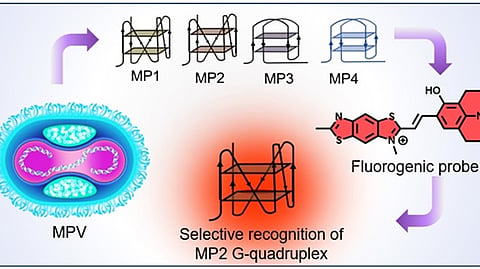One such DNA structure is the G-quadruplex (GQ), a unique noncanonical conformation found in guanine-rich nucleic acid sequences. GQs form planar tetrads through hydrogen bonding among guanines, stacking to create a stable configuration. These structures deviate from the classical double helix and have shown promise as targets for small-molecule fluorescent probes. By leveraging these unusual structures, scientists aim to develop precise diagnostic assays for MPV.
A research team from Jawaharlal Nehru Centre for Advanced Scientific Research (JNCASR), under the Department of Science and Technology (DST), has identified highly conserved GQ-forming sequences in the MPV genome. Their study pinpointed four specific GQ sequences that are stable under physiological conditions, absent in other pox viruses, and distinct from the human genome. These unique features make them valuable targets for diagnostic tools and therapeutic interventions.
Using a custom-designed small-molecule fluorescent probe called BBJL, the researchers successfully detected one of these conserved GQ sequences, enabling highly accurate identification of MPV. The probe exhibited a more than 250-fold fluorescence enhancement when bound to the MPV GQ structure, demonstrating exceptional sensitivity and specificity. “The molecular probe BBJL sets a benchmark in targeting noncanonical nucleic acids for MPV detection,” said lead researcher Thimmaiah Govindaraju.
Notably, the probe remains non-fluorescent in the absence of its target GQ-DNA, ensuring minimal false positives. This development represents the first practical application of a GQ-targeted diagnostic strategy for detecting MPV. The team’s approach expands upon their earlier GQ-targeted diagnostic platform, GQ-RCP, originally designed for SARS-CoV-2 detection. Their findings, previously published in ACS Sensors, underscore the versatility and potential of GQ-based diagnostics.


